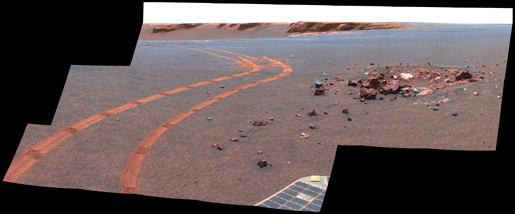
By Dr. Adrian Brown
Planetary Research Scientist at the Carl Sagan Center for the Study of Life in the Universe, SETI Institute
The last two months have witnessed several extremely important events with respect to future Mars Exploration. The first two revolved around the rover "Spirit." The other two are a new mission to Mars and a possible road for humans to Mars.
"Spirit"
On June 3rd, the Mars Exploration Rover (MER) team published a stunning paper describing how the rover "Spirit," now immobile in the shifting sands of Gusev Crater, detected carbonate minerals in a rock called "Comanche Spur." Mostly unwritten in the short article was the painstaking effort that MER scientists, led by Dick Morris of Johnson Space Center, had to go to detect this mineral, in what will surely be one of the MER Rover Missions crowning achievements and scientific touchstones.
On July 30th, NASA announced it had lost contact with "Spirit" in March (a radio silence of 4 months' duration). Although NASA held out hope that they may get contact from the rover in the future, it is highly likely that the immensely successful robot reached the end of its mission. If this isn't the end, then the end will come soon. NASA missions often end this way, and in some ways it's inevitable. Regardless, "Spirit" will go down in the history books as a robot that helped humanity learn about Mars, with many stunning photos and scientific findings.
 Some of the last images transmitted from the stationary MER rover, "Spirit"
Some of the last images transmitted from the stationary MER rover, "Spirit"
--Image courtesy of NASA/JPL
New Mission to Mars
On August 1st, NASA announced a joint US-ESA mission to explore the atmosphere of Mars using super-sensitive spectrometers. The primary objective of the mission will be to conclusively determine the amount of methane in the Martian atmosphere. Methane has long been sought as a possible "biomarker" of subsurface life on Mars. Since Mars has no ozone layer, Martian microbes might have moved underground where the rocks give them protection from harsh UV rays on the surface. Underground, the microbes might be munching on minerals in rocks and producing methane as a waste gas (likes cows on Earth) that gets up to the Martian atmosphere. In 2009 a report in the journal Science by the NASA Goddard scientist Michael Mumma and his team suggested they had indeed found methane in the Martian atmosphere. The problem was, the methane seemed to vary, and even disappeared entirely in 2006. To solve this methane riddle, in 2016, NASA and ESA will send a satellite equipped with an instrument that will look at the sun through the Martian atmosphere on the edge of the planet and look for absorption of light at the characteristic wavelengths of methane.
Possible Road for Humans
In the private sector, on June 4th, the first Falcon 9 rocket blasted off successfully from Cape Canaveral and delivered its payload successfully into orbit. SpaceX's CEO, Elon Musk, is not engaged in rocketry simply to get rich for a third time. Musk is not simply a CEO serving at the pleasure of a board, and neither is he particularly burdened by having to turn a profit for his shareholders. His stated intention in developing the capabilities of SpaceX is to enable a human mission to Mars. His companies' recent and continuing success brings that goal closer to reality. If he remains at the helm of SpaceX, and barring any unfortunate accidents, continued government tacit approval of SpaceX should ensure its bright future. I am sure Musk has a year in mind for when he would like to launch a mission to Mars. The difficulty may reside in making such a venture profitable, or at least to give it the appearance of being profitable. Perhaps SpaceX will operate an ISS cargo run for 3-5 years, and aim at a lunar launch before 2020. Surely then a manned Mars mission would be on the cards before 2030? Musk will be 60 in 2031 - so perhaps he himself will not make the voyage, but he will be fit enough as a CEO to shepherd the Mars mission through.
Living Microbes on Mars -- can't go there until we see 'em, but can't find them without going there?
So this leads us finally to the quandary the whole human race has to solve about microbes on Mars. We haven't found them yet, and maybe they're in such difficult-to-reach locations underground that it might be necessary to send humans to drill down and find them. But humans going to Mars are likely to carry their own set of terrestrial microbes who will almost certainly set up shop on Mars and start their own microbe colonies and wipe out any trace of Martian life without us even knowing.
(Of course this assumes human microbes would win a Darwinian war with Martian microbes, maybe because we have had more evolution happen on our planet, fed by abundant resources. This could be a specious argument!)
In the next two decades, chances are we will have the ability to send humans to Mars, but we will still not be sure about whether there is life on Mars. This is why I think NASA and ESA have to get serious about sending robots to Mars that will directly tackle the question of life on the Red Planet - extant or fossilized life. Up until now, rovers have been built to go to the most boring, flat regions of Mars (and we've still managed to extract some great science!). Now is the time to design robotic landing systems that we can take to the most challenging places - Valles Marineris, a huge chasm the width of the US that was likely filled with water in the past, the north polar water ice cap, a huge reservoir of water which has trapped Martian atmospheric samples for the last 5 million years, the Martian gully sites where water has been seen to flow within the past 6 years, Olympus Mons, the biggest volcano in the solar system, and Nili Fossae, an ancient part of the Martian crust where a team led by Bethany Ehlmann (then of Brown University) reported that they found carbonate minerals in outcrop in 2008.
"La mesa estaba puesta, pero los microbios marcianos acudieron a la fiesta?
I recently had the privilege of being the lead author on a scientific paper expanding on the carbonate discovery by Ehlmann et al. My co-authors were a group of NASA-sponsored researchers from around the US (SETI Institute, Jet Propulsion Laboratory, Johns Hopkins University, and Desert Research Institute) and in Brazil (Universidade Estadual de Campinas, Sao Paulo). The story was picked up by Victoria Gill of the BBC and has been reported on worldwide, which is a big thrill for a junior scientist such as myself and even for the experienced team that backed me up.
The primary message of the paper is that we have found a location on Mars which is very similar to an ancient part of the Earth that is known to have been inhabited. The best evidence of early life on Earth is found in the Pilbara region of Western Australia. The Pilbara rocks are 3.5 billion years old and those rocks have wavy forms called "stromatolites" which indicate life was present at that time. Our research on these rocks using infrared spectroscopy gave us confidence we could recognize similar rocks on Mars.
Now, using an instrument called the Compact Reconnaissance Imaging Spectrometer for Mars (CRISM) on Mars Reconnaisance Orbiter (MRO) run by Johns Hopkins University, we have investigated the Nili Fossae region further, and found intriguing similarities between the chemistry and mineralogy of the Pilbara and the Nili Fossae rocks. Both locations are similar in age; both contain abundant carbonate and accompanying minerals (such as talc). This indicates to my co-authors and I that they formed under similar conditions (in the presence of neutral, warm waters with lots of minerals to feed upon) meaning that when the rocks formed at Nili Fossae, about 3.9 billion years ago, this region on Mars was habitable.
The question that remains now is -- we know Mars was habitable, but was it inhabited by life? The conditions were right, but did life take advantage of them? To borrow a metaphor, "The table was set, but did Martian microbes come to the party?"
You can find a copy of the paper at my website; it is the #1 link on this page.
If you are interested in space science, you may be interested to know that the SETI Institute runs a free weekly talk series that is made globally available on YouTube. Also available is a link to the upcoming talks and subscription details.

 The MER "Opportunity" avoided this hazard automatically. Rovers are going to have to
The MER "Opportunity" avoided this hazard automatically. Rovers are going to have to